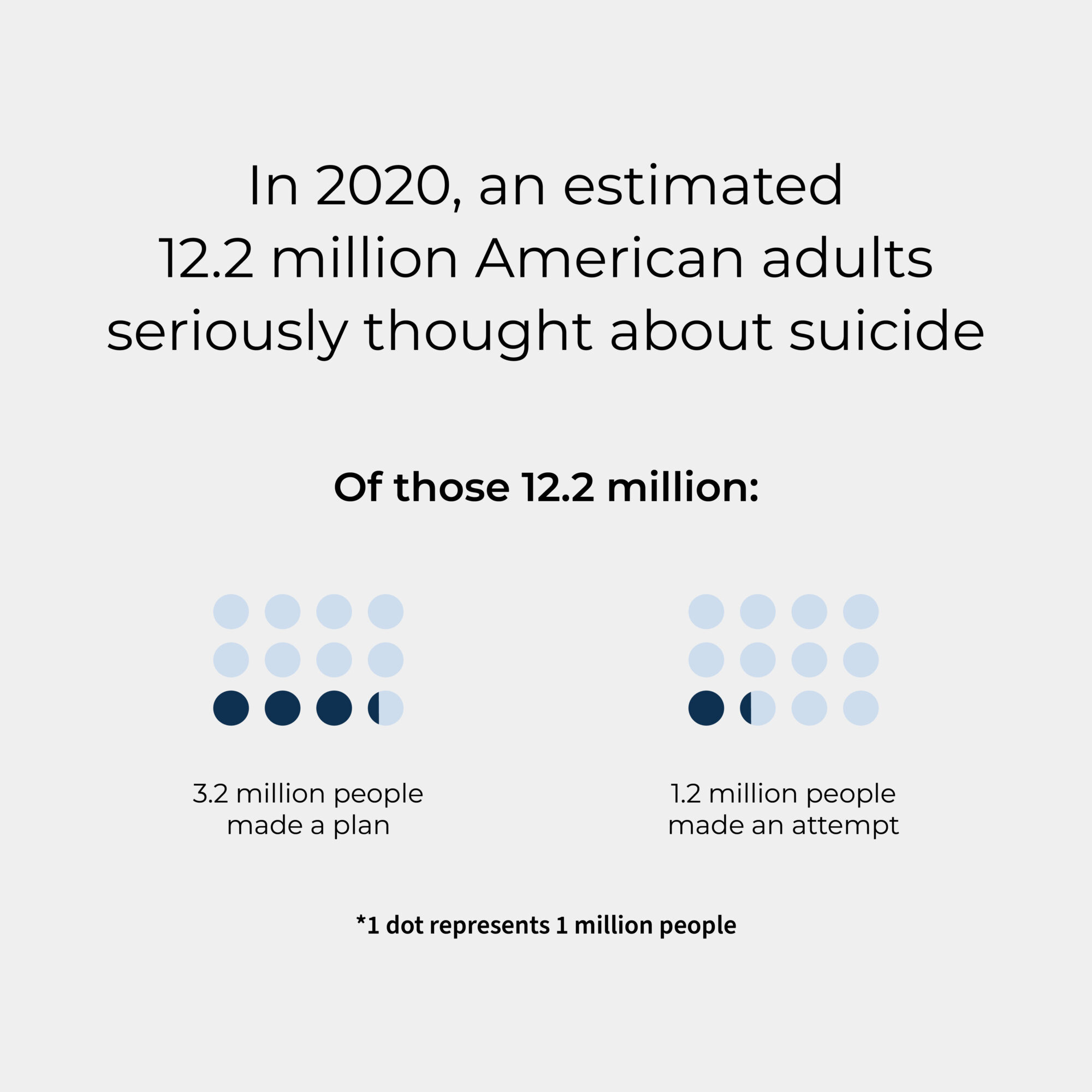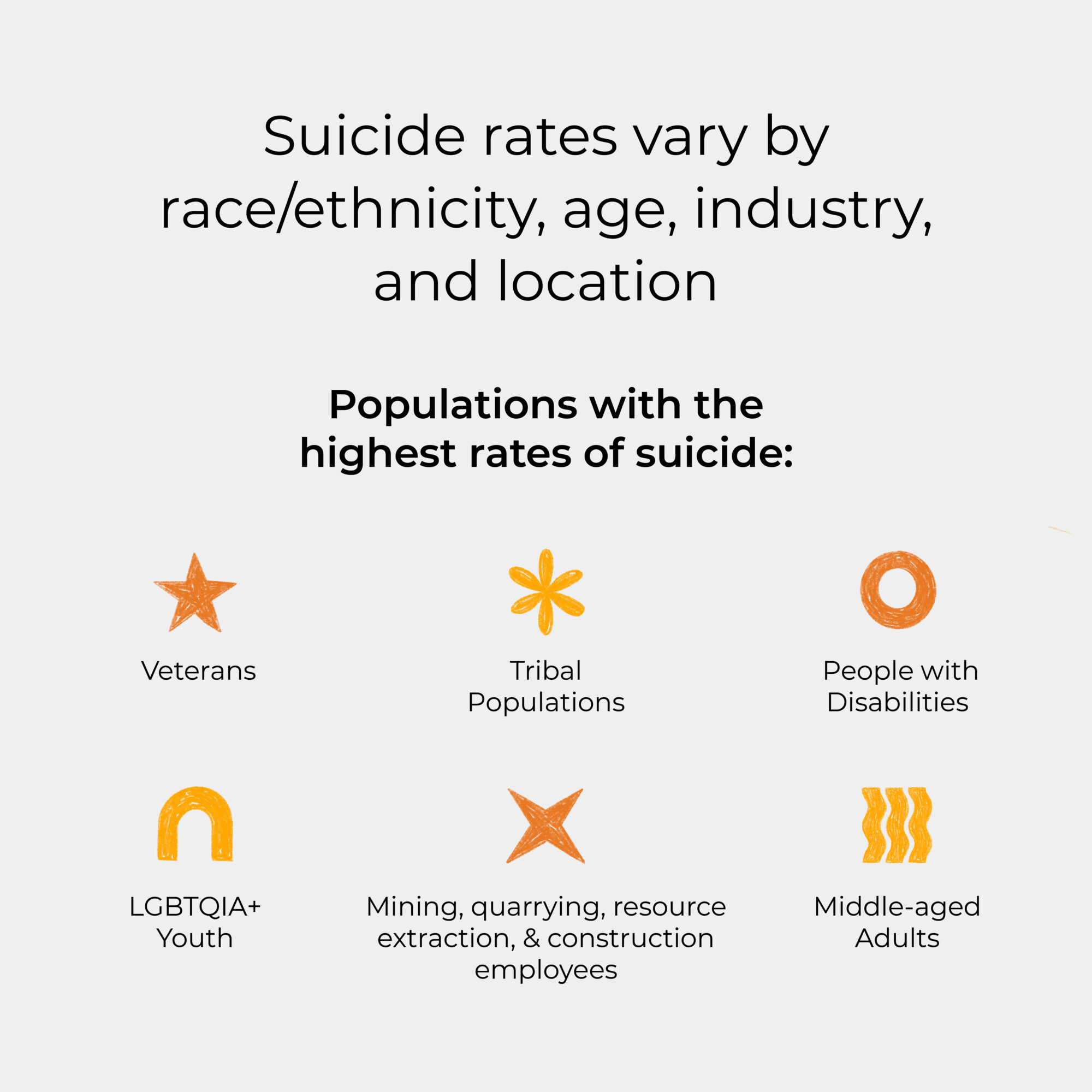September is Suicide Prevention Awareness Month. We want to share more information about suicide, not just the statistics, but also why it happens, who is at risk, what to look for, and what we can do to create more safety. We encourage you to share these resources with your loved ones.
These conversations can be painful and potentially triggering. If you or someone you know is struggling or in crisis, please call or text 988 for the Suicide & Crisis Lifeline.
Suicide by the Numbers
Suicide is a leading cause of death in the United States, with 45,979 deaths in 2020 alone. There are individual, relational, communal, and societal factors that contribute to someone’s risk for suicide.
When we familiarize ourselves with the risk factors, we’re better equipped to assess risk and look out for each other:
- Individual level: history of mental illnesses, hopelessness, substance abuse, chronic health conditions, genetic & biological determinants, previous suicide attempts, violence victimization & perpetration.
- Relationship level: high conflict or violent relationships, sense of isolation & lack of social support, loved one’s history of suicide, financial & work stress.
- Community level: inadequate community connectedness, barriers to health care.
- Societal level: availability of lethal means of suicide, unsafe media portrayals of suicide, stigma associated with help-seeking & mental illness.
Prevention goes a long way in reducing risk. We’ve compiled our prevention and awareness info on our Instagram Resources highlight, and we invite you to share with your communities to spread awareness and save lives. You can find in-depth information with this factsheet from the CDC: Preventing Suicide Guide.
Fighting Mental Health Stigma
Mental health stigma causes many people to suffer in silence, leading to further trauma and pain. Those who have lost a loved one to suicide often look back at their previous interactions, wondering if there was any way they could’ve recognized the signs. They may feel guilt or shame, but the truth is most of us don’t know what to look for. We want to change that.
Here are some of the warning signs for suicide from NAMI. These signs usually start small, with comments or thoughts about suicide (suicidal ideation) like “I wish I weren’t here,” or “Nothing matters.” Over time, they can become more direct and escalate with other behaviors:
- Increased alcohol or drug use
- Aggressive behavior
- Withdrawal from friends, family, & community
- Dramatic mood swings
- Impulsive or reckless behavior
If you or a loved one start to take steps to make a suicide plan, please seek immediate emergency intervention. Collecting and saving pills or buying a weapon, giving away possessions or tying up loose ends (organizing legal documents, paying off debts), saying goodbye to friends or family, and being uncharacteristically sentimental are signs of an impending plan.
It’s essential to be open, honest, calm, and nonjudgmental and to quickly reach out for professional support in a suicide-related crisis. NAMI has prepared more crisis resources, including a guide for navigating a mental health crisis.
We all benefit from sharing mental health resources. Taking action to inform yourself and others is one of the greatest ways to reduce stigma and save lives.
At-Risk Populations
Suicide impacts people across various demographics, but did you know that certain groups are more at risk? According to the CDC, some groups that are at higher risk for suicide include:
- Veterans
- Tribal populations
- Middle-aged adults
- LGBTQIA+ youth
- People with disabilities
- People who work in mining, quarrying, oil and gas extraction, and construction
Men are more likely to die by suicide, and rates are higher among certain racial and ethnic groups. Suicide rates can vary substantially across geographic regions, and people living in rural areas have much higher rates of suicide than people living in urban areas.
The CDC has identified actions that healthcare systems, the public health sector, schools, employers, media, communities, and individuals can take to lower suicide rates, and you can learn more here. One way you can help is by identifying and supporting people at risk by learning the warning signs, asking the right questions, and having a plan to help those at risk.
Community, advocacy, and awareness can go a long way in removing the barriers to mental health. Still, we must address the systemic issues that actively cause harm, like poverty, limited access to healthcare, violence, discrimination, and mental health stigma.
Suicide Prevention: Creating More Safety
Suicide prevention shouldn’t just be about helping people survive; we must create avenues for people to thrive and participate in the full spectrum of the human experience. The CDC has outlined policies that can help keep our communities safe:
- Strengthen economic support with unemployment benefits, livable wages, accessible healthcare, disability and retirement insurance, and housing stabilization policies.
- Strengthen access and delivery of suicide care with better mental health coverage and expanded telehealth services.
- Create protective environments by reducing access to lethal means for persons at risk of suicide.
- Create organizational policies and cultures that fight stigma and promote mental health.
- Establish community-based policies to reduce alcohol use.
- Promote connectedness by developing peer norm programs and community engagement activities.
- Teach coping and problem-solving skills with social-emotional learning programs and caregiver classes that promote positive parent-child interactions.
- Identify and support people at risk with gatekeeper training, crisis intervention, and expanded access to behavioral health treatment.
- Lessen harm and prevent future risk with postvention support and safe reporting.
We need to work together to make a change. You can read more about the different strategies and approaches we can take as individuals and organizations, plus evidence, references, and more in the CDC’s publication: Preventing Suicide Package.
Getting Support
All of us at APN want you to know that the world is a better place with you in it. Your presence is a unique light; even in the darkest moments, there is hope. If you need non-emergency support to address the root causes of depression and suicidal ideation, we can help.
Our team can connect you with treatment options, from All Points North and other providers, based on your individual needs. Start a conversation today by filling out our contact form, starting a live chat, or calling 855.235.9792.






